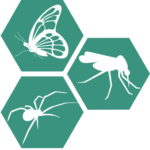Lab 1: Arthropod Collection and Identification
Goal:
To introduce students to the spectacular diversity and abundance of arthropods and to prepare specimens for DNA analysis.
Learning Objectives:
Students will conduct field work to collect insects from local fauna. Upon completion of this activity, students will appreciate the ubiquity of symbiotic microbes in animals, formulate a testable hypothesis, understand how to use a taxonomic key to identify arthropods to Order, and prepare lab notes and specimens for molecular studies.
Teaching Time: One class period
Recommended PROJECT GUIDE

Arthropod Collection Traps

- Project Supplement: Arthropod Collection Traps (9/21) (.docx / .pdf)
- Video: Brown Sugar and Yeast Trap (YouTube)
- Video: Flying Insect Trap (YouTube)
FAQs
Q. Can my student(s) collect dead arthropods?
A. Yes, absolutely. Because DNA degrades after death, a negative Wolbachia result could mean that the arthropod was, in fact, uninfected or the DNA is degraded/undetectable. Make sure the student also runs an arthropod PCR and ask them to hypothesize about the detection of both host and microbial DNA. Which DNA, if any, do they expect to degrade the fastest?
Q. Do you have any recommendations for introducing The Wolbachia Project in the winter?
A. Below are three recommended options. Please contact us with more ideas.
- Have your students form their hypotheses and complete collections in the late Summer/Fall when weather is still warm. Store the arthropods in 95% ethanol in a freezer until you are ready to move on to the rest of the project.
- While arthropod abundance and diversity may be lower in the winter, there are still plenty to collect. Students may need to revise their hypotheses to test indoor/urban arthropods. They might be surprised how many arthropods are living in their garages and windowsills. You may also explore local businesses (grocery, nursery, vet office) or visit a nearby nature park and ask for recommendations.
- Do you live near a zoo, aquarium, or insectarium? Oftentimes, they will donate dead arthropods to classrooms. You may be able to ask them to preserve the specimen soon after death to preserve the DNA.
